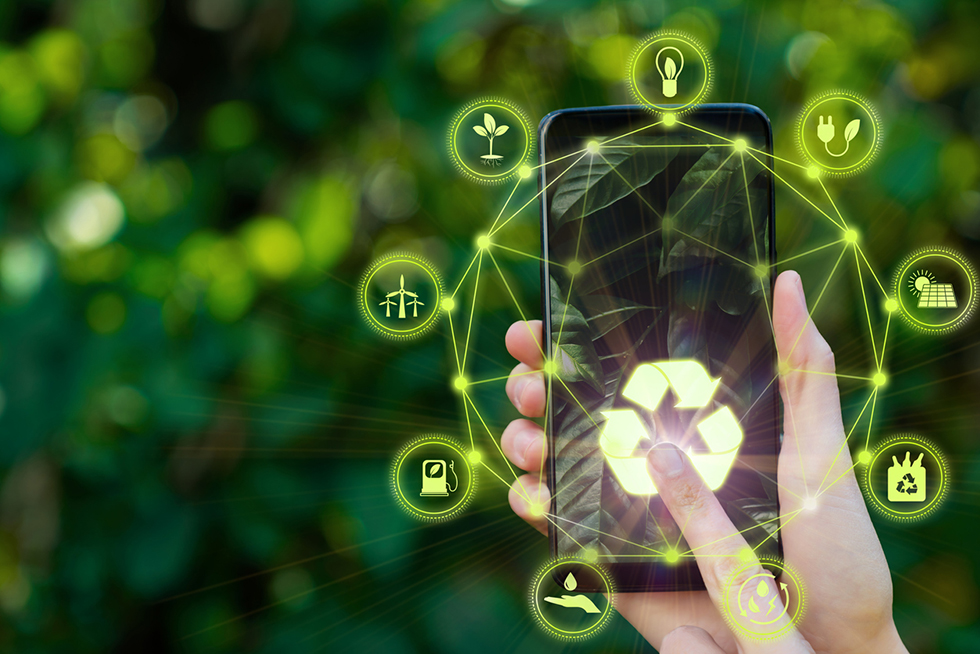Our smartphones have changed human behaviour immeasurably. They have helped to revolutionised business, increased our productivity, made financial transactions effortless and provided encyclopaedic knowledge at a touch of a smart screen.
By the beginning of 2022, the number of smartphone users globally, exceeded 6.6 billion, almost 84% of the world’s population*. Sales of smartphones have doubled since 2016,** – and so too has the consequential mountain of e-waste, pollution and related greenhouse gas emissions as our old handsets are frequently discarded in favour of one with upgraded features.
Smartphones are heating our planet faster than any other electrical appliance. In 2019, their environmental footprint surpassed the contribution made by desktops, laptops, and monitors^^. Recent studies have shown the greenhouse gas emissions from our mobiles are increasing at an unprecedented 730% every year+. It is simply not sustainable to continue as we are.
85-95% of a smartphones total greenhouse gas emissions comes from its production.
World Economic Forum.
These devices are a vital part of our digital transformation, but it is essential that we begin to think beyond their average 2- 3-year lifecycle.
If consumers extended their upgrade cycle by just one year, the associated emissions would be reduced by 33%^^. If all EU citizens made this change, it would be the equivalent of taking 2 million cars off the roads. A recent Digital Trends survey reported that over a quarter of people say a poor battery-life is the main reason for their upgrade.

Why did manufacturers stop using removable smartphone batteries?
Mobile device producers have responded to criticism by no longer including chargers with new handsets, providing buy-back schemes and using renewable electricity to power their vast servers. Whilst a step forward, there is nothing that resolves the issues relating to device longevity.
However, manufacturers bonded the battery to the casing for good reason. A removable battery requires a plastic layer for impact protection but a bonded battery takes up less space, enabling multi-lens cameras, stereo-quality speakers and a slim design of glass and metal for a more premium handset. By sealing the device’s exterior, manufacturers released the water and dust resistance models that consumers demanded. Of course, if the casing can be opened, this lowers the phone’s protection.
Should legislation insist on replaceable smartphone batteries?
In 2020, it was reported that the European Commission was to create a new regulation, which would mean that all manufacturers designed their new smartphones with replaceable batteries. The new law, which would contribute to e-waste reduction targets and form part of the circular economy strategy, is also expected to include tablets and earphones. The ‘right to repair’ legislation also holds producers to account when it comes to sustainability.
Common within most smartphones until the early 2010’s, the removable battery was once a key part of the Samsung’s marketing strategy against Apple. Whilst Samsung’s XCover model still has a replaceable battery, no leading manufacturer has released a flagship model with an easily removable battery in many years.
As tech giants, the industry leaders have the capability to create mobile handsets with interchangeable power or storage capacity, if they chose to do so. After all, start-up’s such as Netherlands-based, Fairphone has brought easy to upgrade, modular phones to market. Terracube’s DIY capable phones are designed for ‘ultra-easy’ home repairs.
The term ‘non-removable battery’ is a little misleading… even bonded smartphone batteries can be removed at specialist centres. Although this prevents third-party or DIY repairs, it is possible to replace a battery through your manufacturer, although this can be expensive. Whereas, smartphones designed with repair and remanufacture in mind from the outset, allow for longer lifetime value and greater recycling efficiency.
Many of the more recent features can be attributed to the ‘non-removable battery’, such as faster, wireless charging. Given the option, would consumers opt for a longer lasting handset if it saved them money? Would they be happy with fewer features if it reduced emissions, e-waste and the associated soil, water and air pollution from leaching chemicals?

How do you safely dispose of your businesses smartphones?
Buy back schemes.
To demonstrate their recognition of the short lifecycles, most manufacturers offer a reasonable discount if you trade-in an old handset at the point-of-purchase – potentially giving components a second, third or even forth life. They even accept phones in a poor condition; some accept devices that don’t power on, although you cannot expect a £200 discount here, of course. Leaving phones gathering dust in desk drawers, many organisations are failing to regain money from mobile device asset recovery, but for those who do, it is crucial that your organisation removes all data from the handsets before despatch.
It is a common ITAD myth, that by applying a factory-reset to your device, you remove all data from your handset.
Any company mobile device will contain data, documents and records that you certainly wouldn’t want to be seen externally. These mini-computers can hand cyber-criminals easy access to your organisations network. A data breach could lead to some very serious consequences should your smartphone disposal policy not meet the EU and UK GDPR data destruction requirements. When your smartphone becomes faulty or is due for an upgrade, it is essential that the device is treated in exactly the same way you would treat any other end of life IT asset or piece of redundant IT equipment to prevent any data governance issues in the future.
As many businesses upgrade cycles are actioned in bulk, these buy-back schemes can be harder to manage internally. Most IT asset disposal companies can help with the secure data erasure mobile devices, supplying a full ITAD chain of custody, an IT asset disposition accreditation certificate and peace of mind that the device has undergone complete data destruction.

Female hand is using smartphone with environment icons over network connection. Concept saving energy in nature, growth and success. Ecology conservation by technology. Earth day. Save planet.
Recycle and reuse.
The good news is that the majority of components within a mobile phone can be recycled and by choosing to recycle devices through your ITAD supplier, you will receive the residual value for the recovered parts – a handy boost for any IT budget.
Most people are aware that smartphones contain plastic, glass and metal, but many other precious metals are used in our devices. According to the US Environmental Protection Agency, 1 million recycled smartphones contain 35,274 pounds of copper, 772 pounds of silver, 75 pounds of gold, and 33 pounds of palladium. We are literally throwing money away. By recycling these elements, fewer finite natural resources need to be removed from the planet. There are 30 naturally occurring components used to produce our smartphones – six of these will run out in the next 100 years++.
The recycled components not only make new smartphones; they can be reprocessed to create memory sticks, speakers, cameras, automotive parts and garden furniture. The batteries can power other rechargeable devices, such as lighting or combined to create EV charging stations.
Donate.
Although many take it for granted, there are still 1.9 million UK households with no access to the internet. For them, a smartphone could provide a link to essential services, such as education or medical services. As part of their CSR or sustainability policy, some businesses are choosing to donate redundant IT assets, either for use in the UK or overseas, where mobile ownership is not so affordable. However, it is important to use your data wiping services prior to donation to protect company data.

As longevity of a device through replacing its battery or other components will ultimately result in fewer new devices being sold, a regulatory framework seems the only likely way to achieve systemic change, with the EU hoping to lead the rest of the world with new legislation.
It is also up to consumers and businesses to make ethical choices. This may be choosing modular models, extending the lifetime of their devices by exercising their right to repair or by responsibly disposal either through buy-back, recycling or donation schemes.
Considering the full lifecycle of our phones is key when it comes to tackling the e-waste crisis with smartphones contributing to 10% of global e-waste generated each year, a waste stream equating to an estimated 50 million tonnes – or 300,000 double-decker buses.
The most accredited ITAD company in the UK, tier1 offer a complete and secure mobile device recycling solution using Blancco Mobile Edition Software, designed specifically for secure data erasure of mobile devices. Our comprehensive recycling and free IT asset disposal services offer hassle-free environmentally friendly ITAD ensuring you and remain compliant with industry legislation at all times.
Find out how we can support your organisation – contact us on 0161 777 1000 or visit tier1.com
* bankmycell.com, **Statista, ^ World Economic Forum, ^^ McMaster University, Canada, +Digital Trends, ++The Royal Society of Chemistry,
Resources.
Business Insider, makeuseof.com, Science ABC, Screen Rant, Science Direct, Android Central, U Switch, Tree Hugger, World Economic Forum, Royal Society of Chemistry, bankmycell.com, The Restart Project, Earth 911, Statista,



